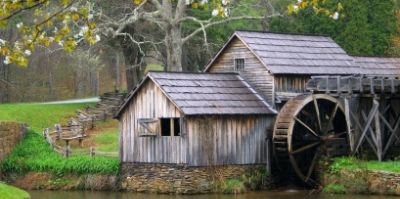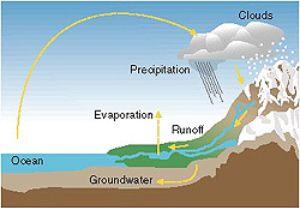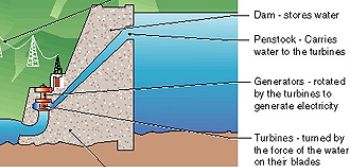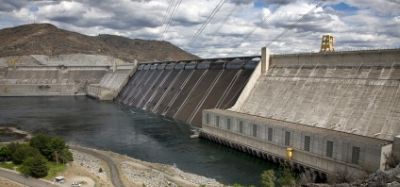|
Hydropower
Hydropower refers to power obtained from the flow of moving water. Along wind, it’s one of the oldest forms of power generation. The earliest forms, of course, were water wheels. These have been in use for at least 2000 years. In the past, water wheels created mechanical energy to turn shafts to accomplish tasks such as grinding grain or sawing wood. The energy had to be used at the point of production. Today, hydropower plants use turbines to generate electricity. In the form of electricity, the energy can be transported from the river of origin to where it's needed. Types of HydropowerOn this page, I'm going to talk about hydroelectric dams. These large scale project are by no means the only to generate hydro power. On other pages, I discuss things like Run of River Hydro Power, Small Hydropower, Wave Power and Tidal Power. Let's begin here with the hydrologic cycle. It may surprize you to learn that the energy in a flowing river originates from the sun. Hydropower Originates From the SunIt is interesting to note that you can think of hydropower as a form of solar energy. The basis of this is what scientists refer to as the hydrologic cycle.
Hydrologic Cycle The cycle begins with the sun heating water on the surface of the earth. This causes the water to evaporate into moisture vapor in the air. The warm air rises carrying the water with it as it does. The air cools at higher altitudes the water begins to condense to form clouds. Eventually it falls to earth again as rain or snow. When it does, the water will have traveled a considerable distance. Consider that most of the water in the winter snows of the Rocky Mountains comes the Pacific Ocean. In a very real sense, the sun’s energy carries the water to the mountain tops. Rains and melting snow feed the rivers and streams that flow downhill to return the water to the ocean. Hydroelectric plant capture some of the energy of that flow to put it to use. Head and FlowTwo terms describe the power generating potential of a river or stream: head and flow. Head is how far the water drops across a distance. A one hundred foot water fall has a one hundred foot head. Flow is how much water is passing by measured in gallons per minute. Waterfalls with the same drop have different generating potential depending on how much water flows over them. Early water mills were set up where there was a naturally occurring drop in a river bed over a short distance. In other words, by waterfalls and rapids. The first commercial hydroelectric plant in the United States was at Niagara Falls, certainly an impressive demonstration of the power of falling water. Water power can be harnessed when the change in river level is less dramatic by building a dam. Hydroelectric DamsDams create some advantages. They are controversial for reasons we’ll mention, but first let’s consider the advantages. For one, they increase the average water level which increases the potential power output. Dams also allows operators to control flow to match energy needs. Additionally, the reservoir behind the dam represents stored energy. Electricity can be reliably produced even if rain and snowfall varies. The reservoir makes steady power generation less dependent on even rainfall.
At a hydroelectric dam, water from the reservoir behind the dam is directed through pipes containing turbines. The flow water spins the turbines, which drives a generator to produce electricity. An interesting characteristic of hydropower production is that energy can be stored. If more water is flowing over a dam than electricity needs of the moment, the electricity can be used to pump water back to the reservoir so it can flow down again later. Obviously, some energy is lost in the process, but this ability is unique to hydropower – coal and gas burning plants can’t store energy in a similar way. Electricity produced from hydro plants is cheap and clean. After all, the fuel – flowing water – is free and there are absolutely no emissions. The turbine generators are relatively simple (as these things go) and low maintenance. The Downside of Hydroelectric DamsThe glitch in all this is the environmental impact of building a dam. The reservoir floods land upstream. The dam forms a physical barrier to migrating fish. It interrupts the normal development of flood plains downstream. For reasons like these, getting regulatory permission had become a lengthy and costly. This can be a very emotional debate. It’s a little odd, though, that environmentalists often adamantly oppose any hydroelectric project when electricity generated in such a way is among cleanest possible. I would hope that we could weigh the overall environmental impact from a larger perspective and compromises. Certainly changes in the design and construction of dams, such including fish ladders to allow fish to migrate around them, can reduce some of the environmental concerns.
Grand Coulee Dam In the United States today, there are over 80,000 dams. Only about 2,000 of these are used to generate electricity. “Small hydro” projects hope to use these dams to generate electricity at financially viable costs. LinksClick here to go to Alternative Energy Primer Home from Hydropower |



